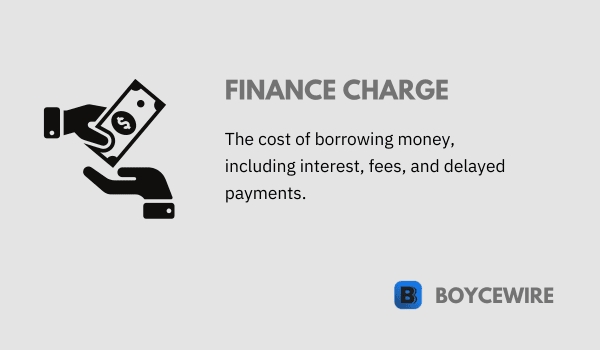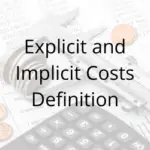Finance Charge: How to Calculate, How to Minimize, & Examples

What is a Finance Charge?
Finance charges represent a fundamental aspect of lending and credit transactions, influencing the total cost borne by consumers and the profitability for lenders. A finance charge is broadly defined as the cost of borrowing money, which can include not only interest but also other fees associated with a loan or credit transaction. It is typically applied to transactions involving credit cards, mortgages, auto loans, and other forms of lending.
Understanding how finance charges work is crucial for individuals and businesses alike as they have a direct impact on personal financial health and business profitability. In this article, we will explore the concept of finance charges in-depth, explaining how they are calculated, their impact, strategies for minimizing them, and providing examples to help better illustrate these points. Whether you’re considering taking out a loan, using a credit card, or simply wanting to improve your financial literacy, this guide will provide you with the knowledge you need to navigate the world of finance charges effectively.
Key Points
- A finance charge is a fee or interest imposed by a lender on a borrower for the use of credit or for delaying payment on a loan or credit card.
- Finance charges are calculated based on the outstanding balance of the loan or credit card and the applicable interest rate or fees.
- Finance charges can include various components such as interest, late fees, annual fees, balance transfer fees, and other charges associated with credit use.
Understanding Finance Charges
A finance charge is any cost or fee associated with borrowing money, primarily in the form of interest. It represents the price one pays for the convenience of accessing funds they do not currently possess. Finance charges are most commonly found in lending scenarios like mortgage loans, auto loans, credit card balances, and other forms of credit. They are a primary source of revenue for lending institutions and credit card companies.
Finance charges can be structured in several ways. Some may be a flat fee, while others are a percentage of the amount borrowed or the remaining balance. They are typically influenced by a variety of factors, such as the borrower’s creditworthiness, the type and duration of the loan, prevailing market rates, and whether any collateral is involved.
One significant aspect of finance charges is that they compound over time. For instance, if a credit card balance is not paid in full, finance charges will be applied to the unpaid balance, and the following month, finance charges will be applied to the original balance plus the previous month’s finance charges, leading to a compounding effect. This feature can cause debt to grow quickly if not managed effectively.
Overall, understanding how finance charges work can help individuals and businesses manage their finances more effectively, make informed borrowing decisions, and find ways to minimize these charges.
Calculating Finance Charges
Calculating finance charges can vary based on the type of credit you’re using. Different types of loans and credit cards may have different methods for calculating finance charges, often stipulated in the loan agreement or credit contract.
Credit Cards: Most credit card issuers calculate finance charges using your average daily balance during the billing cycle. The issuer will take the sum of your balance on each day of the billing cycle and then divide that total by the number of days in the billing cycle. This gives the “average daily balance.” Then, the average daily balance is multiplied by the daily interest rate (annual interest rate divided by 365) and the number of days in the billing cycle to calculate the finance charge.
Loans (Mortgage, Auto, Personal, etc.): For many loans, finance charges are part of your monthly payment and calculated using the simple interest method. This involves multiplying your loan balance by the interest rate, then multiplying by the number of time periods to calculate the finance charge. Some loans may also use an amortization schedule, where the proportion of your payment allocated to the principal and interest changes over time.
Payday Loans: These types of loans often come with a flat finance charge rather than an interest rate. The lender specifies a fee to be paid by the end of the term, which can be quite high relative to the amount borrowed.
Always remember to read your credit agreements carefully to understand how finance charges are calculated. If unsure, it can be beneficial to ask your lender or issuer for a clear explanation. Understanding these calculations can help you manage your debts and make smarter financial decisions.
Effect of Finance Charges
Finance charges can significantly impact the cost of borrowing and, consequently, your personal finances. Here’s how:
- Cost of Borrowing Finance charges are essentially the cost of borrowing money. If the finance charges are high, then the cost of borrowing will also be high, making the loan or credit card more expensive. On the other hand, low finance charges mean that the cost of borrowing is less.
- Debt Repayment Finance charges can affect how quickly you’re able to pay off your debt. Higher finance charges mean you could be paying more towards interest rather than the principal debt amount, slowing down the speed at which you can clear your debt.
- Monthly Payments In many cases, finance charges are included in your monthly loan or credit card payments. If your finance charges increase, for example due to a higher outstanding balance or an increase in interest rates, your required monthly payment may also increase.
- Long-term Financial Health High finance charges can impact your long-term financial health, especially if you’re regularly carrying a balance on high-interest credit cards or loans. The cumulative effect of paying high finance charges can lead to significant financial strain over time, potentially leading to a cycle of debt that can be difficult to break free from.
It’s important to understand how finance charges are calculated and applied to your loans or credit cards. This understanding can help you make more informed borrowing decisions and potentially save money in the long run.
How to Minimize Finance Charges
Minimizing finance charges can save you a significant amount of money, especially over the long term. Here are some strategies to reduce these charges:
- Pay Your Balances in Full The most effective way to avoid finance charges on credit card accounts is to pay off your balance in full each month before the grace period ends. By doing this, you avoid any finance charges on purchases made during that billing cycle.
- Timely Payments Make sure to make all of your payments on time. Late payments can result in additional fees, higher interest rates, and increased finance charges.
- Choose Low-Interest Credit Products When choosing credit cards or loans, opt for those with lower interest rates. A lower rate means lower finance charges for the same balance.
- Pay More than the Minimum Due If you can’t pay your balance in full, try to pay more than the minimum required payment. This reduces your principal balance faster, leading to lower finance charges in the future.
- Limit Borrowing The less you borrow, the lower your finance charges will be. Use credit sparingly and aim to save for purchases ahead of time to avoid the need for credit.
- Negotiate Interest Rates If you’ve been a good customer, you may be able to negotiate a lower interest rate with your credit card company or lender, reducing your future finance charges.
- Balance Transfers If you have a high-interest credit card, consider transferring the balance to a card with a lower interest rate. Be mindful, however, of any balance transfer fees.
Remember, managing finance charges isn’t just about reducing costs – it’s also an essential part of maintaining healthy personal finances.
Legal Aspects of Finance Charges
The law requires transparency and honesty from lenders when it comes to finance charges. Here are some legal aspects associated with these charges:
- Truth in Lending Act In the United States, the Truth in Lending Act requires lenders to disclose all terms and costs associated with borrowing, including the finance charge. This information is typically provided on a “Truth in Lending Disclosure Statement.”
- Annual Percentage Rate (APR) The APR must be disclosed to borrowers. This rate includes not only the interest rate but also other finance charges that may apply over the course of a year. It provides a more accurate representation of the cost of borrowing.
- Usury Laws Many states and countries have usury laws, which place a cap on the maximum amount of interest that can be charged. These laws are designed to prevent predatory lending practices.
- Penalties for Late Payment The lender must disclose any additional finance charges or penalties that may apply if a payment is late or missed.
- Variable Rates If the finance charge is variable (meaning it can change), the lender must explain when and how the charge can change.
- Fair Credit Billing Act Under this U.S. act, consumers have the right to dispute inaccuracies about finance charges on their bills. If a consumer disputes a charge within 60 days of receiving the bill, the creditor must investigate and correct any errors promptly.
Violations of these legal requirements can result in penalties for the lender, including fines and regulatory actions. Therefore, it’s crucial for both borrowers and lenders to understand the legal aspects of finance charges.
Examples of Finance Charges
- Credit Card Interest Perhaps the most common example of a finance charge is the interest that accrues on a credit card balance. If you carry a balance on your credit card from one month to the next, your card issuer will charge you interest on that balance. This interest is a finance charge.
- Mortgage Interest When you take out a mortgage to buy a home, your lender will charge you interest on the amount you borrowed. This interest is another example of a finance charge.
- Auto Loan Interest If you finance your vehicle with an auto loan, you’ll be charged interest on the loan balance. Like mortgage and credit card interest, this is a type of finance charge.
- Late Payment Fees If you’re late with a payment on a credit card, mortgage, or other type of loan, your lender might charge you a late payment fee. This fee is considered a finance charge because it’s a cost associated with borrowing money.
- Loan Origination Fees Some lenders charge a fee to process a new loan. This fee, known as an origination fee, is a type of finance charge.
- Overdraft Fees If you overdraft your bank account, your bank will typically charge you a fee. Since you’re effectively borrowing money from the bank when you overdraft your account, this fee is considered a finance charge.
- Cash Advance Fees If you take a cash advance from your credit card, you’ll likely be charged a fee. This is another example of a finance charge.
Remember, finance charges can add up quickly, especially when they compound. It’s essential to understand all the potential finance charges associated with any credit account or loan to ensure you make informed borrowing decisions.
FAQs
A finance charge is the fee or interest imposed by a lender on a borrower for the use of credit or for delaying payment on a loan or credit card.
The finance charge is calculated based on the outstanding balance of the loan or credit card and the applicable interest rate or fees.
No, finance charges can vary depending on the type of credit, such as personal loans, credit cards, or mortgages, and the terms and conditions set by the lender.
In some cases, finance charges can be avoided by paying off the full balance before the due date or using interest-free credit options.
About Paul
Paul Boyce is an economics editor with over 10 years experience in the industry. Currently working as a consultant within the financial services sector, Paul is the CEO and chief editor of BoyceWire. He has written publications for FEE, the Mises Institute, and many others.

Further Reading
 Explicit and Implicit Costs: Definition & Examples - An explicit cost is the clearly stated costs that a business incurs. For example, employee wages, inputs, utility bills, and…
Explicit and Implicit Costs: Definition & Examples - An explicit cost is the clearly stated costs that a business incurs. For example, employee wages, inputs, utility bills, and…  Correlation Coefficient - The correlation coefficient is a statistical measure that quantifies the strength and direction of the linear relationship between two variables.
Correlation Coefficient - The correlation coefficient is a statistical measure that quantifies the strength and direction of the linear relationship between two variables.  White Collar: Definition & Examples - A white collar is the name used to define a segment of employees that earn higher than average wages in…
White Collar: Definition & Examples - A white collar is the name used to define a segment of employees that earn higher than average wages in… 